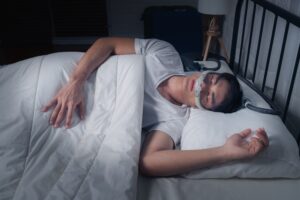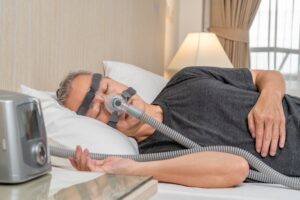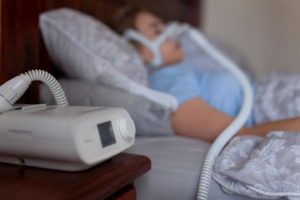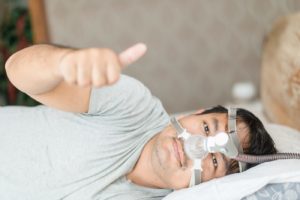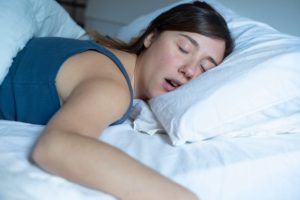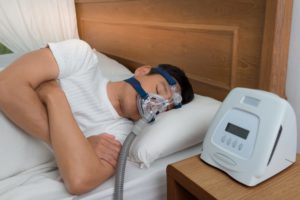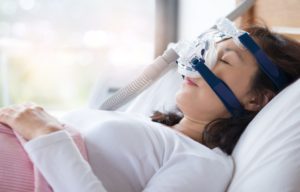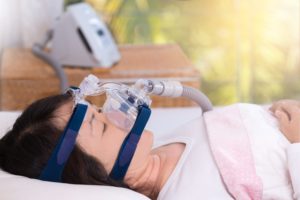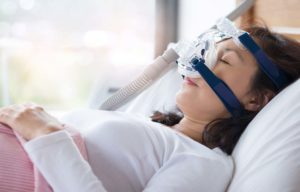Before and After CPAP Machine Effects: How Your Body Changes
Continuous positive airway pressure (CPAP) therapy is often the first treatment recommended for people with a diagnosis of sleep apnea. Sleep apnea involves repeated pauses in breathing during sleep. A CPAP machine delivers air into a mask connected to the nose or mouth and nose, which helps keep the airway open and prevent pauses as a person breathes.
People prescribed a CPAP machine may wonder how their bodies change in response to CPAP use. CPAP therapy is considered safe and has been found to provide many benefits, such as better sleep, reduced snoring, less daytime fatigue, and decreased blood pressure. We take a closer look at how CPAP treatment impacts the body and various aspects of health.
Suspect You May Have Sleep Apnea?
Answer three questions to understand if you should be concerned.
The Link Between CPAP Use and Weight
A higher body weight is often associated with the most common type of sleep apnea, called obstructive sleep apnea (OSA). Each 10% of weight increase is linked to a six-times higher risk of OSA. While it is clear obesity can increase the risk of OSA, studies also suggest that having OSA may cause a person to gain weight . For this reason, some researchers have suggested that treating OSA with a CPAP machine may lead to weight loss. The actual research on CPAP and weight has produced mixed results, however.
Can CPAP Therapy Help You Lose Weight?
While older research has suggested CPAP use could help people lose weight, more recent analyses of dozens of studies have found that weight may actually increase after a person with OSA begins CPAP treatment. Therefore, people with OSA who are overweight should not rely on CPAP therapy alone to help with weight loss. Instead, experts recommend that people continue other strategies to help reduce body weight.
Why Can CPAP Therapy Cause Weight Gain?
Researchers are not entirely sure why treating OSA with a CPAP machine can lead to weight gain. Identifying how CPAP use affects weight is difficult, because so many factors impact body weight, like diet, physical activity, hormones, and other environmental factors. For these reasons, studying the impact of CPAP on weight is challenging and research is limited. Yet, experts have speculated several possible causes of weight gain while people are on CPAP therapy.
- Changes in energy usage: Untreated OSA may cause people to use more energy as they sleep, either due to low oxygen levels or an overactive nervous system. Thus, when people with OSA start CPAP, they may begin using less energy during sleep . Studies have also found that the basal metabolic rate drops after starting CPAP, which means people burn fewer overall resting calories. Burning fewer calories might result in weight gain for some people.
- Having high blood sugar: Weight gain after CPAP use appears to happen more commonly among people who already had existing issues with the regulation of blood sugar, such as those with diabetes. In these cases, weight gain after CPAP may relate to how quickly the body responds to insulin, a hormone that regulates blood sugar and works to store body fat.
- Increases in waist sizes with CPAP use: This is not a measure of weight per se, but doctors sometimes use waist size to determine if a person has obesity. Some people may gain weight in the abdominal area after CPAP use, but not all studies on CPAP use and weight have found an increase in waist size.
- Time spent using CPAP machine: Weight changes may depend on how much time people spend using CPAP nightly. One analysis found that weight gain only happened in those who used their CPAP machine for less than five hours per night. But, another showed that those who use a CPAP for over four hours per night tend to gain more weight. These inconsistent results make it difficult to determine if time spent using a CPAP truly impacts weight.
- Increases in lean body mass: Other studies suggest weight gain after CPAP use could be due to an increase in lean muscle mass, but not body fat in some people.

Improved Alertness
Treating OSA with CPAP therapy has been found to reduce daytime sleepiness and increase their alertness. Even one night of CPAP use can lead to improved attention the next day.
Some people with OSA might have residual sleepiness even after treatment with CPAP therapy might not reduce sleepiness. People at the highest risk for residual sleepiness include those with more sleepiness to begin with, younger adults, people who use the CPAP machine for fewer hours each night, and those with depression.
Reduced Symptoms of Depression and Anxiety
Studies show that treating OSA with CPAP can reduce symptoms of anxiety and depression , though these effects may be less impactful in people who also have coronary artery disease. Although experts are not certain about the exact effect OSA has on anxiety and depression, some suggest the low oxygen levels associated with OSA may lead to brain changes that affect mood. This may explain why CPAP therapy improves mental health for some people.
Better Cardiovascular Health
Studies of CPAP therapy and cardiovascular health have provided mixed results . Earlier studies of those undergoing CPAP treatment did not find any difference in the risk of cardiovascular issues, like stroke or heart attack. However, some researchers believe this result was due to study design choices.
More recently, an analysis of five studies found that, among people who have OSA, using a CPAP machine for at least four hours per night reduces the risk of stroke.There are a few reasons why CPAP use might reduce the risk of stroke in those with OSA. First, OSA can cause fluctuations in blood pressure, low levels of oxygen in the blood, and high levels of carbon dioxide in the blood. All of these can negatively impact blood flow in the brain, but treatment with CPAP may help steady these fluctuations and lower stroke risk.
Experts suggest that OSA may contribute to build up in the arteries, called atherosclerosis, as well as an irregular heart rhythm called atrial fibrillation, both of which can also contribute to stroke. Treating these OSA-related risk factors with CPAP could, therefore, also help protect individuals against these types of stroke.
Lower Blood Pressure
People with OSA face an increased risk of high blood pressure. Studies show treating OSA with CPAP therapy reduces blood pressure an average of 2 to 3 mm Hg . Blood pressure improvements may only be seen in those who use a CPAP machine for at least four hours per night. Reducing high blood pressure can reduce a person’s risk of cardiovascular events like heart attack and stroke.
Interestingly, some people may receive greater benefit from CPAP therapy than others. For example, those who have high blood pressure that has persisted despite using medication may benefit more from CPAP use. Research has also suggested that African-Americans may see greater blood pressure-related benefits from CPAP use than others.
While CPAP may help reduce blood pressure, it is important for people to continue to follow their doctors’ recommendations for blood pressure management. This is because medications and lifestyle measures still play important roles in blood pressure control.
Reduced Heart Failure Risk and Severity
Both OSA and a more rare type of sleep apnea called central sleep apnea often overlap with heart failure . Generally, OSA contributes to the development of heart failure, while central sleep apnea develops after heart failure is present.
Research shows that treating sleep apnea with CPAP helps improve the heart dysfunction common in heart failure. CPAP therapy may help protect against heart failure symptoms through the way it impacts the left ventricle of the heart, as well as by altering nervous system activity that affects blood pressure and heart rate.
Fewer Headaches
OSA can cause a person to wake up with a morning headache, but experts are not entirely sure why this is the case. Treating OSA with CPAP has been found to reduce these morning headaches and headaches in general.
When it comes to headaches, some people may experience greater benefit from CPAP therapy than others. For example, men appear to receive more headache relief from CPAP therapy than women.
Improved Diabetes Symptoms
Experts suspect treating OSA with CPAP may improve blood sugar control , but studies remain inconclusive.
Insulin resistance involves the body becoming less sensitive to insulin, a hormone that helps regulate blood sugar. People who have insulin resistance may develop diabetes or experience the disorder more severely. Some, but not all, studies suggest that CPAP treatment for OSA can reduce insulin resistance . Therefore, more research is needed.
Some people with diabetes experience vision problems like color blindness or macular edema . And, studies show CPAP could improve these complications in people living with diabetes. In one case study, CPAP therapy combined with weight loss education successfully reversed the green tint a man with diabetes had begun seeing overtop his entire visual field. However, in another study of those with OSA, type 2 diabetes, and macular edema, CPAP treatment did not lead to any improvements in eyesight .
Fewer Male Reproductive Issues
While there remain very few studies on this topic, males with OSA may face a greater risk of infertility , as was demonstrated by a large study out of Taiwan.
OSA may play a role in the development of male infertility through many ways, like changes in hormone levels, a build-up of oxygen-containing toxins, insulin resistance, and erectile dysfunction . More research is needed, but studies are starting to show that CPAP and other OSA treatments may help lower males’ risk of infertility.
A Healthier Pregnancy
Sleep apnea occurs more commonly during pregnancy, and becomes more severe as the pregnancy goes on. Experts suggest sleep apnea with CPAP therapy can improve the health of the fetus.
Pregnant people who had sleep apnea before pregnancy and are already being treated with CPAP therapy may need to have the air pressure of their machine adjusted during and after pregnancy, since pregnancy can worsen the severity of OSA.
What to Do if You Think You May Have Sleep Apnea
If you experience symptoms of sleep apnea, talking to your doctor or your health care provider is a good idea. People with sleep apnea often feel tired during the day, wake up with a dry mouth or headache, and are told by partners that they snore, gasp, or stop breathing during sleep.
Your doctor can ask you about risk factors and symptoms you are experiencing to determine if you should undergo a sleep study. If you do end up being diagnosed with a type of sleep apnea, your health care provider may suggest CPAP therapy, the treatment prescribed most often for the disorder.

Still have questions? Ask our community!
Join our Sleep Care Community — a trusted hub of product specialists, sleep health professionals, and people just like you. Whether you’re searching for the perfect mattress or need expert sleep advice, we’ve got you covered. Get personalized guidance from the experts who know sleep best.
References
19 Sources
-
Kline, L. R. (2022, June 1). Clinical presentation and diagnosis of obstructive sleep apnea in adults. In N. Collop (Ed.). UpToDate., Retrieved October 7, 2022, from
https://www.uptodate.com/contents/clinical-presentation-and-diagnosis-of-obstructive-sleep-apnea-in-adults -
Drager, L. F., Brunoni, A. R., Jenner, R., Lorenzi-Filho, G., Benseñor, I. M., & Lotufo, P. A. (2015). Effects of CPAP on body weight in patients with obstructive sleep apnoea: A meta-analysis of randomised trials. Thorax, 70(3), 258–264.
https://pubmed.ncbi.nlm.nih.gov/25432944/ -
Chen, B., Drager, L. F., Peker, Y., Vgontzas, A. N., Phillips, C. L., Hoyos, C. M., Salles, G. F., Guo, M., & Li, Y. (2021). Effect of continuous positive airway pressure on weight and local adiposity in adults with obstructive sleep apnea: A meta-analysis. Annals of the American Thoracic Society, 18(10), 1717–1727.
https://pubmed.ncbi.nlm.nih.gov/33740390/ -
Tachikawa, R., Ikeda, K., Minami, T., Matsumoto, T., Hamada, S., Murase, K., Tanizawa, K., Inouchi, M., Oga, T., Akamizu, T., Mishima, M., & Chin, K. (2016). Changes in energy metabolism after continuous positive airway pressure for obstructive sleep apnea. American Journal of Respiratory and Critical Care Medicine, 194(6), 729–738.
https://pubmed.ncbi.nlm.nih.gov/26930227/ -
Djonlagic, I., Guo, M., Matteis, P., Carusona, A., Stickgold, R., & Malhotra, A. (2015). First night of CPAP: Impact on memory consolidation attention and subjective experience. Sleep Medicine, 16(6), 697–702.
https://pubmed.ncbi.nlm.nih.gov/25953301/ -
Pepin, J. L. (2021, April 24). Evaluation and management of residual excessive sleepiness in adults with obstructive sleep apnea. In N. Collop & T. E. Scammell (Eds.). UpToDate., Retrieved October 11, 2022.
https://www.uptodate.com/contents/evaluation-and-management-of-residual-excessive-sleepiness-in-adults-with-obstructive-sleep-apnea -
Lee, M. C., Shen, Y. C., Wang, J. H., Li, Y. Y., Li, T. H., Chang, E. T., & Wang, H. M. (2017). Effects of continuous positive airway pressure on anxiety, depression, and major cardiac and cerebro-vascular events in obstructive sleep apnea patients with and without coronary artery disease. Tzu-chi Medical Journal, 29(4), 218–222.
https://pubmed.ncbi.nlm.nih.gov/29296051/ -
Javaheri, S., Martinez-Garcia, M. A., Campos-Rodriguez, F., Muriel, A., & Peker, Y. (2020). Continuous positive airway pressure adherence for prevention of major adverse cerebrovascular and cardiovascular events in obstructive sleep apnea. American Journal of Respiratory and Critical Care Medicine, 201(5), 607–610.
https://pubmed.ncbi.nlm.nih.gov/31644880/ -
Shafazand, S., & Patel, S. R. (2014). Effect of CPAP on blood pressure in patients with obstructive sleep apnea and resistant hypertension. Journal of Clinical Sleep Medicine, 10(3), 341–343.
https://pubmed.ncbi.nlm.nih.gov/24634635/ -
Kato, T., Suda, S., & Kasai, T. (2014). Positive airway pressure therapy for heart failure. World Journal of Cardiology, 6(11), 1175–1191.
https://pubmed.ncbi.nlm.nih.gov/25429330/ -
Johnson, K. G., Ziemba, A. M., & Garb, J. L. (2013). Improvement in headaches with continuous positive airway pressure for obstructive sleep apnea: A retrospective analysis. Headache, 53(2), 333–343.
https://pubmed.ncbi.nlm.nih.gov/22963547/ -
Steiropoulos, P., & Papanas, N. (2011). Continuous positive airway pressure to improve insulin resistance and glucose homeostasis in sleep apnea. World Journal of Diabetes, 2(1), 16–18.
https://pubmed.ncbi.nlm.nih.gov/21537446/ -
Iftikhar, I. H., Hoyos, C. M., Phillips, C. L., & Magalang, U. J. (2015). Meta-analyses of the association of sleep apnea with insulin resistance, and the effects of CPAP on HOMA-IR, adiponectin, and visceral adipose fat. Journal of Clinical Sleep Medicine, 11(4), 475-485.
https://pubmed.ncbi.nlm.nih.gov/25700870/ -
Raman, R., Verma, A., Srinivasan, S., & Bhojwani, D. (2018). Partial reversal of color vision impairment in type 2 diabetes associated with obstructive sleep apnea. GMS Ophthalmology Cases, 8, Doc05.
https://pubmed.ncbi.nlm.nih.gov/29623253/ -
National Eye Institute (August 5, 2022). Macular edema., Retrieved October 14, 2022, from
https://www.nei.nih.gov/learn-about-eye-health/eye-conditions-and-diseases/macular-edema -
West, S. D., Prudon, B., Hughes, J., Gupta, R., Mohammed, S. B., Gerry, S., Stradling, J. R., & ROSA trial investigators (2018). Continuous positive airway pressure effect on visual acuity in patients with type 2 diabetes and obstructive sleep apnoea: A multicentre randomised controlled trial. The European Respiratory Journal, 52(4), Article 1801177.
https://pubmed.ncbi.nlm.nih.gov/30166323/ -
Jhuang, Y. H., Chung, C. H., Wang, I. D., Peng, C. K., Meng, E., Chien, W. C., & Chang, P. Y. (2021). Association of obstructive sleep apnea with the risk of male infertility in Taiwan. JAMA Network Open, 4(1), Article e2031846.
https://pubmed.ncbi.nlm.nih.gov/33475753/ -
Kyrkou, K., Alevrakis, E., Baou, K., Alchanatis, M., Poulopoulou, C., Kanopoulos, C.,Vagiakis, E. & Dikeos, D. (2022). Impaired human sexual and erectile function affecting semen quality, in obstructive sleep apnea: A pilot study. Journal of Personalized Medicine, 12(6), 980.
https://pubmed.ncbi.nlm.nih.gov/35743765/ -
Izci Balserak B. (2015). Sleep disordered breathing in pregnancy. Breathe, 11(4), 268–277.
https://pubmed.ncbi.nlm.nih.gov/27064321/






